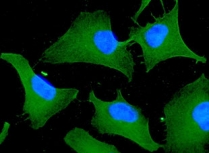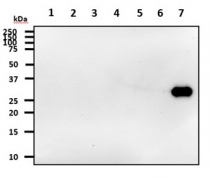ARG57092
anti-14-3-3 tau / YWHAQ antibody [1A1]
anti-14-3-3 tau / YWHAQ antibody [1A1] for ICC/IF,Western blot and Human
Overview
| Product Description | Mouse Monoclonal antibody [1A1] recognizes 14-3-3 tau / YWHAQ |
|---|---|
| Tested Reactivity | Hu |
| Tested Application | ICC/IF, WB |
| Host | Mouse |
| Clonality | Monoclonal |
| Clone | 1A1 |
| Isotype | IgG1, kappa |
| Target Name | 14-3-3 tau / YWHAQ |
| Antigen Species | Human |
| Immunogen | Recombinant fragment around aa. 1-245 of Human 14-3-3 tau / YWHAQ |
| Conjugation | Un-conjugated |
| Alternate Names | 14-3-3; Protein HS1; 1C5; HS1; 14-3-3 protein theta; 14-3-3 protein tau; 14-3-3 protein T-cell |
Application Instructions
| Application Suggestion |
|
||||||
|---|---|---|---|---|---|---|---|
| Application Note | * The dilutions indicate recommended starting dilutions and the optimal dilutions or concentrations should be determined by the scientist. |
Properties
| Form | Liquid |
|---|---|
| Purification | Purification with Protein G. |
| Buffer | PBS (pH 7.4), 0.02% Sodium azide and 10% Glycerol. |
| Preservative | 0.02% Sodium azide |
| Stabilizer | 10% Glycerol |
| Concentration | 1 mg/ml |
| Storage Instruction | For continuous use, store undiluted antibody at 2-8°C for up to a week. For long-term storage, aliquot and store at -20°C. Storage in frost free freezers is not recommended. Avoid repeated freeze/thaw cycles. Suggest spin the vial prior to opening. The antibody solution should be gently mixed before use. |
| Note | For laboratory research only, not for drug, diagnostic or other use. |
Bioinformation
| Database Links | |
|---|---|
| Gene Symbol | YWHAQ |
| Gene Full Name | tyrosine 3-monooxygenase/tryptophan 5-monooxygenase activation protein, theta |
| Background | This gene product belongs to the 14-3-3 family of proteins which mediate signal transduction by binding to phosphoserine-containing proteins. This highly conserved protein family is found in both plants and mammals, and this protein is 99% identical to the mouse and rat orthologs. This gene is upregulated in patients with amyotrophic lateral sclerosis. It contains in its 5' UTR a 6 bp tandem repeat sequence which is polymorphic, however, there is no correlation between the repeat number and the disease. [provided by RefSeq, Jul 2008] |
| Function | Adapter protein implicated in the regulation of a large spectrum of both general and specialized signaling pathways. Binds to a large number of partners, usually by recognition of a phosphoserine or phosphothreonine motif. Binding generally results in the modulation of the activity of the binding partner. Negatively regulates the kinase activity of PDPK1. [UniProt] |
| Calculated MW | 28 kDa |
| PTM | Ser-232 is probably phosphorylated by CK1. |
Images (4) Click the Picture to Zoom In
-
ARG57092 anti-14-3-3 tau / YWHAQ antibody [1A1] ICC/IF image
Immunofluorescence: HeLa cells line stained with ARG57092 anti-14-3-3 tau / YWHAQ antibody [1A1] at 1:100 (Green).
DAPI (Blue) for nucleus staining.
-
ARG57092 anti-14-3-3 tau / YWHAQ antibody [1A1] WB image
Western blot: 20 µg of Jurkat cell lysate stained with ARG57092 anti-14-3-3 tau / YWHAQ antibody [1A1] at 1:1000.
-
ARG57092 anti-14-3-3 tau / YWHAQ antibody [1A1] WB image
Western blot: 50 ng of Human 1) YWHAZ, 2) YWHAB, 3) YWHAE, 4) YWHAH, 5) YWHAG, 6) SFN, and 7) YWHAQ recombinant proteins stained with ARG57092 anti-14-3-3 tau / YWHAQ antibody [1A1] at 1:1000.
-
ARG57092 anti-14-3-3 tau / YWHAQ antibody [1A1] WB image
Western blot: 40 µg of 1) MDA-MB-21, 2) HeLa, 3) A431, 4) NIH3T3, 5) 293T, and 6) HepG2 cell lysates stained with ARG57092 anti-14-3-3 tau / YWHAQ antibody [1A1] at 1:1000.









